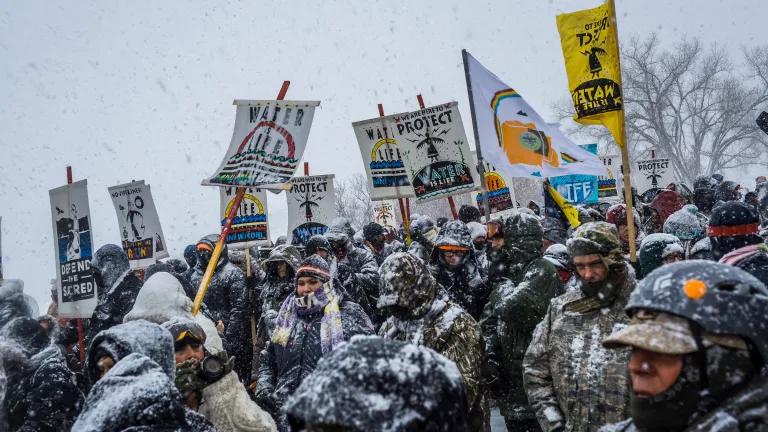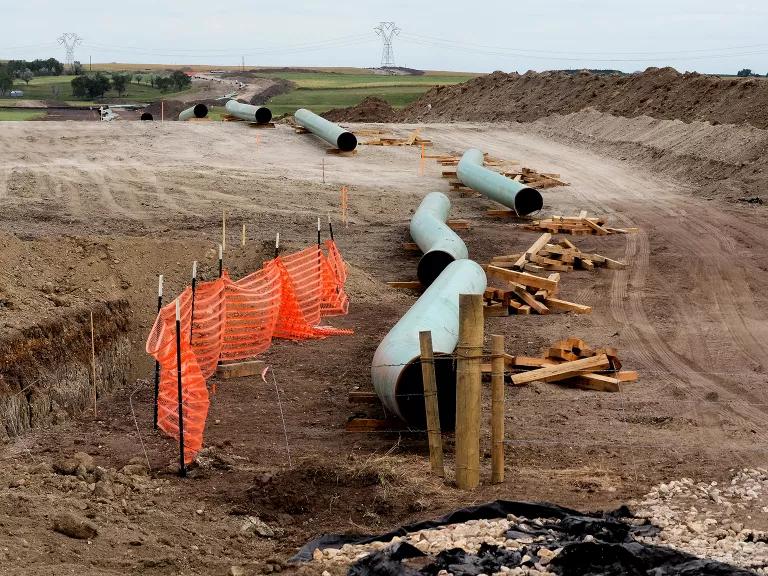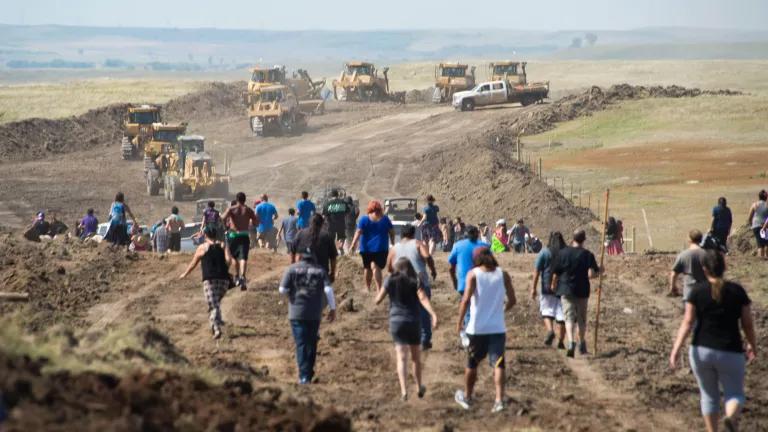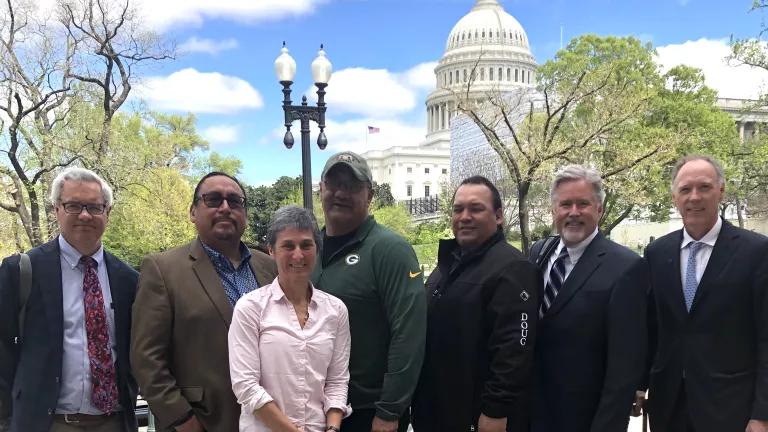Huge Win for Standing Rock and the National Environmental Policy Act
A federal court orders the U.S. Army Corps of Engineers to write a full environmental impact statement for the Dakota Access Pipeline.

Water protectors march against the construction of the Dakota Access Pipeline at Oceti Sakowin Camp near the Standing Rock Reservation in 2016.
Today, in a major win against the Dakota Access Pipeline (DAPL), Judge James Boasberg of the U.S. District Court for the District of Columbia determined that the pipeline remains “highly controversial” under the National Environmental Policy Act (NEPA), found that the U.S. Army Corps of Engineers had not “adequately discharged its duties under that statute,” and ordered the Army Corps to prepare a full Environmental Impact Statement (EIS). The court will also order a briefing on whether to shut down the pipeline while the EIS is being prepared. This is a major development in the four-year-old DAPL lawsuit, which has pitted the governments of the Standing Rock Sioux and Cheyenne River Sioux tribes against the government of the United States and the oil industry stakeholders that operate and use the pipeline.
The tribes attended a court hearing on March 18 to determine whether additional studies on the pipeline’s environmental impacts were adequate under NEPA. They contended that the impacts of the pipeline have never been properly evaluated. They cited numerous violations of federal pipeline regulations, such as the failure to properly account for a worst-case oil spill in the Missouri River, relied upon by the tribes for community drinking water supplies, as well as fish and wildlife.
“After years of commitment to defending our water and earth, we welcome this news of a significant legal win,” said Standing Rock Sioux tribe chairman Mike Faith. This is thanks to a successful collaboration between legal experts, scientists, and policy experts—including NRDC staff who serve on the tribal technical team.
To the tribes, and those in the greater environmental community, the construction and ongoing operation of DAPL represented a failure by the federal government, which, under NEPA, is supposed to protect affected communities when it issues permits for large infrastructure projects, like oil pipelines. The principles of environmental justice emphasize the need to be especially vigilant when low-income communities are impacted or when, as here, pipelines are allowed to pose risks to tribal communities that have treaties with the United States to protect their remaining tribal lands. The next steps for the tribes will be to make this point during the briefing to discuss whether to vacate the easement during this remand—in other words, to shut down the pipeline while the EIS is being prepared.
NEPA, the only law that allows for local public input on infrastructure projects, is currently under attack by both the Trump administration and some members of Congress. That should make us watch the Standing Rock case even more closely. DAPL foreshadows a future where dangerous infrastructure could be built anywhere and at any time without local consent. But just as DAPL serves as an ominous symbol for environmental destruction and corporate greed, the spirit of NEPA and the Standing Rock protesters—now plaintiffs against the federal government—serve as a beacon of hope for the environmental movement.
As NRDC continues fighting against the neverending onslaught of environmental rollbacks and NEPA attacks by President Trump and his supporters in Congress, it will continue to stand with Standing Rock, as it has since the historic protests of 2016. Otherwise, more DAPL situations are sure to come. But the ruling today gives us hope and sets a strong precedent for upholding NEPA.
A Brief History of DAPL
Energy Transfer LP, the pipeline operator notorious for being one of the worst pipeline safety violators in the nation, began construction of the pipeline in June 2016. It was halted first by peaceful protesters and later by the Army Corps under the Obama administration, to give the Corps time to conduct an EIS. But President Trump allowed construction to resume by executive order just four days into office.
DAPL has been operating for nearly three years now, transporting nearly half a million barrels of crude oil per day over a thousand miles from western North Dakota, under the Missouri River, through South Dakota and Iowa, to the Patoka Oil Terminal in Illinois. It crosses under the Missouri River just a quarter mile from the Standing Rock reservation, which means if a leak or spill occurred there, the oil would leak up through the riverbed, wash downstream, and contaminate the drinking water supply for the tribe. A subsurface spill would be extremely difficult to contain, much like the challenges faced during the Deepwater Horizon disaster in the Gulf of Mexico.

The Dakota Access Pipeline under construction in 2016
There have been 12 spills during the pipeline’s first 18 months of operation, resulting in the release of more than 6,000 barrels of oil. The risk to the Missouri River—a valuable water source for the tribes and a major river system for the nation—is real.
The tribes have been fighting DAPL in court for nearly four years now. In June 2017, in what seemed like a win at the time, a federal judge in the U.S. District Court for the District of Columbia found that the Army Corps had not adequately considered the environmental impacts of the pipeline under NEPA. However, the court stopped short of shutting off the pipeline and instead asked for more information from the Army Corps.
After that, the Army Corps no longer consulted with the tribes in good faith, did not consider the tribes’ technical input, nor did it provide the reports and documentation the tribes needed—or when it did, the documents were heavily redacted. Today’s ruling was in response to the tribes’ challenge that the Army Corps did not comply with the June 2017 order.
Next Steps
Standing Rock will need to make its case to the court for why the pipeline should be shut down while the Army Corps goes through the NEPA process.
Meanwhile, Energy Transfer wants to double the flow rate of the pipeline to nearly a million barrels a day, requiring more pumping stations and significantly increasing the pressure inside the pipeline, thereby increasing the risk of a spill. A robust and transparent NEPA process should be followed for this proposal as well.
Members of Congress can help by requesting documents from the Army Corps and the pipeline operators, conducting oversight hearings, and defending NEPA during any infrastructure funding negotiations. They could reauthorize the Pipeline and Hazardous Materials Safety Administration (PHMSA), the federal agency that oversees the national pipeline network, giving it adequate funding and greater authority so it can work more closely with local communities around the country dealing with pipelines running through their backyards. Native American treaty rights must be respected in all pipeline approvals.
Concerned citizens can do their part by calling their elected officials and asking them to defend NEPA. They can also participate in public comment processes for both federal-level rulemakings and also local and regional projects. For instance, the proposal to double DAPL’s throughput should be concerning to anyone living along the pipeline route in North Dakota, South Dakota, Iowa, and Illinois, not just the tribes.
NRDC will continue to stand with Standing Rock and fight to preserve the environmental laws that protect the health and safety of communities around the nation.
To stay connected with Standing Rock, you can follow them on Twitter and Facebook, or you can directly support them by donating at the link on their website homepage, standingrock.org.



